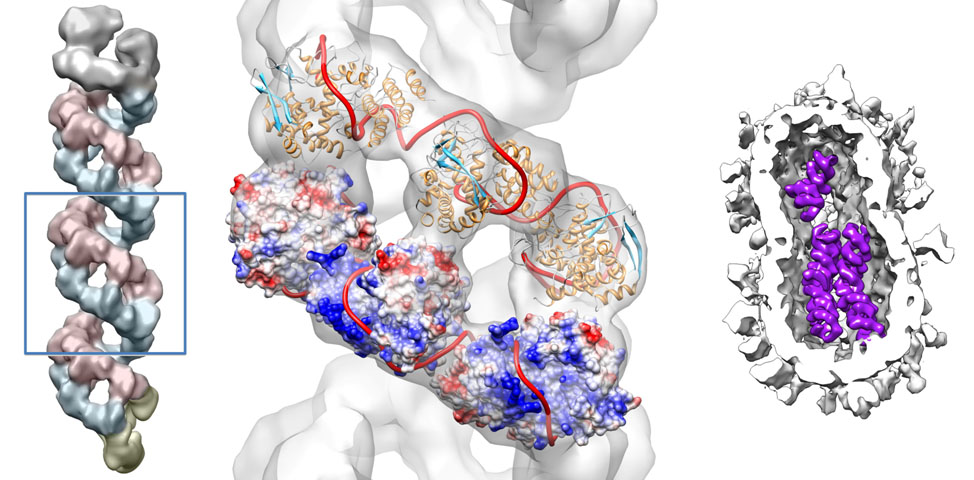Bajo la dirección de Jaime Martín-Benito y Juan Ortín, se acaba de publicar en la revista Science la estructura de las proteínas del virus de la gripe responsables de la replicación y expresión de su material genético.
 Los virus de la gripe A son endémicos en aves y también infectan al hombre y otros mamíferos, causando epidemias anuales y ocasionalmente pandemias que constituyen un grave problema sanitario. Estas epidemias ocasionan un exceso de mortalidad, generalmente en personas de avanzada edad o con su inmunidad debilitada. Además, la amenaza de pandemias de muy alta virulencia sigue siendo un peligro real, como muestran los datos de mortalidad de algunas cepas como la conocida “gripe aviar”. Estos virus de la gripe, del subtipo H5N1, no se transmiten de forma directa entre humanos, pero presentan unas tasas de mortalidad de casi el 60% (359 muertes de 608 casos registrados por la Organización Mundial de la Salud desde 2003 hasta agosto de 2012). La importancia de este patógeno también radica en el enorme impacto económico que tiene, tanto en los gastos directos sanitario-farmacéuticos como en la pérdida de decenas de millones de horas laborales en el mundo, ya que puede llegar a suponer hasta el 12% de las bajas laborables en invierno.
Los virus de la gripe A son endémicos en aves y también infectan al hombre y otros mamíferos, causando epidemias anuales y ocasionalmente pandemias que constituyen un grave problema sanitario. Estas epidemias ocasionan un exceso de mortalidad, generalmente en personas de avanzada edad o con su inmunidad debilitada. Además, la amenaza de pandemias de muy alta virulencia sigue siendo un peligro real, como muestran los datos de mortalidad de algunas cepas como la conocida “gripe aviar”. Estos virus de la gripe, del subtipo H5N1, no se transmiten de forma directa entre humanos, pero presentan unas tasas de mortalidad de casi el 60% (359 muertes de 608 casos registrados por la Organización Mundial de la Salud desde 2003 hasta agosto de 2012). La importancia de este patógeno también radica en el enorme impacto económico que tiene, tanto en los gastos directos sanitario-farmacéuticos como en la pérdida de decenas de millones de horas laborales en el mundo, ya que puede llegar a suponer hasta el 12% de las bajas laborables en invierno.
Un paso importante en el ciclo de vida del virus es la replicación y expresión de su material genético. El mensaje genético del virus está codificado en 8 segmentos de ácido ribonucleico (ARN). El ARN está unido a 4 proteínas diferentes: la polimerasa (compuesta por tres subunidades), que mantiene unidos los extremos del segmento, y múltiples copias de una misma proteína llamada nucleoproteína, que se unen al ARN como si fueran las cuentas de un collar. Esta compleja estructura es conocida como ribonucleoproteína (RNP) y funciona realmente como una máquina molecular, capaz de transcribir el mensaje genético del virus y de autoreplicarse dentro de la célula infectada para así generar la progenie de nuevos virus que infectarán otras células. El conjunto de las 8 RNPs que contienen toda la información genética del virus está empaquetado dentro de cada partícula viral de forma ordenada.
A pesar de su importancia, la información detallada de cómo se organizaban las proteínas y el ARN para generar estas RNPs era muy escasa. Por este motivo, y durante los últimos años, los laboratorios del CNB dirigidos por Juan Ortín, también investigador del CIBER de Enfermedades Respiratorias (CIBERES), y Jaime Martín-Benito han desarrollado un proyecto para la determinación de dicha estructura. La metodología de trabajo consistió en la extracción y purificación de las 8 RNPs presentes en las partículas virales, para posteriormente estudiarlas mediante técnicas de microscopía electrónica y procesamiento computacional de imágenes. Ese procedimiento permitió determinar la estructura de las RNPs aisladas y desvelar la organización de las proteínas que forman esta compleja máquina molecular. Finalmente, y usando técnicas de tomografía electrónica sobre virus intactos, se verificó que la estructura obtenida de las RNPs aisladas era la misma que la que se encontraba dentro del virus infectivo.
La estructura final obtenida muestra una organización de doble hélice con dos cadenas de ARN-nucleoproteína y la polimerasa situada en uno de los extremos del helicoide. Adicionalmente se ha verificado que dentro del virus intacto las diferentes RNPs estan dispuestas formando haces muy estrechamente empaquetados. El análisis de estos resultados, junto con los datos previos existentes, permitirá desvelar algunos de los pasos cruciales en el ciclo de vida del virus tales como los mecanismos por los que las RNPs se replican y expresan la información genética del virus, el modo en que las 8 RNPs se asocian entre sí en la partícula del virus o los mecanismos por los que los genes de virus aviares pueden transferirse a los virus humanos.
- Arranz R, Coloma R, Chichón FJ, Conesa JJ, Carrascosa JL, Valpuesta JM, Ortín J, Martín-Benito J. The structure of native influenza virion ribonucleoproteins. Science doi: 10.1126/science.1228172





